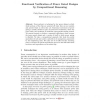Free Online Productivity Tools
i2Speak
i2Symbol
i2OCR
iTex2Img
iWeb2Print
iWeb2Shot
i2Type
iPdf2Split
iPdf2Merge
i2Bopomofo
i2Arabic
i2Style
i2Image
i2PDF
iLatex2Rtf
Sci2ools
CAV
2008
Springer
2008
Springer
Functional Verification of Power Gated Designs by Compositional Reasoning
Power gating is a technique for low power design in which whole sections of the chip are powered off when they are not needed, and powered back on when they are. Functional correctness of power gating is usually checked as part of system-level verification, where the most widely used technique is simulation using pseudo-random stimuli. We propose instead to perform a sequential equivalence check between the power gated design and a version of itself in which power gating is disabled. We take a compositional approach that looks for partial equivalence of each unit under a suitable set of assumptions, guaranteed by the neighboring units. We make use of so-called circular reasoning rules to compose the partial equivalences proved on the individual units back into total equivalence on the whole chip.
| Added | 12 Oct 2010 |
| Updated | 12 Oct 2010 |
| Type | Conference |
| Year | 2008 |
| Where | CAV |
| Authors | Cindy Eisner, Amir Nahir, Karen Yorav |
Comments (0)

